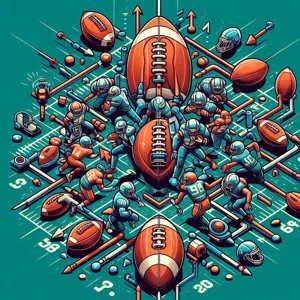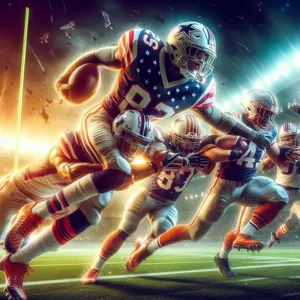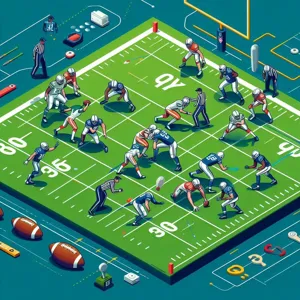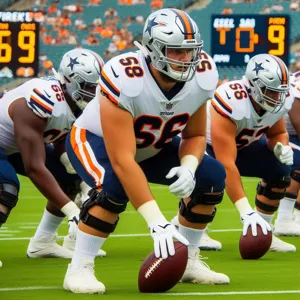In the high-octane world of American football, where every play can determine the outcome of a game, the influence of coaching styles on player performance is profound and multifaceted.
Coaches are not just strategists; they are mentors, motivators, and sometimes even psychologists who shape the very fabric of their teams. The way a coach communicates, inspires, and instills discipline can make all the difference between a team that merely competes and one that dominates on the field. This blog post delves into the various coaching styles prevalent in American football, exploring how each approach—whether it be authoritarian, democratic, or transformational—affects player motivation, teamwork, and overall performance. Join us as we dissect the winning edge that great coaches bring to the game and uncover the secrets behind transforming raw talent into championship-caliber athletes.
1. Introduction to Coaching Styles in American Football

In the world of American football, the role of a coach extends far beyond the Xs and Os of playcalling; it encompasses the very essence of player development and team dynamics. Coaching styles are not just methods; they are reflections of a coach’s philosophy, values, and understanding of the game. From the fiery, motivational approach of a John Madden to the cerebral, analytical style of a Bill Belichick, each coach brings a unique flavor to their team that can significantly influence player performance.
The diversity in coaching styles can be attributed to various factors, including personal background, experience, and the specific needs of the team. Some coaches thrive on fostering a family-like atmosphere, promoting camaraderie and open communication, while others may prioritize discipline and rigorous training regimens. Understanding these different styles is crucial for players aiming to maximize their potential and for teams looking to create a winning culture.
As we delve into the various coaching styles prevalent in American football, we will explore how these methods directly impact not only individual performance but also team cohesion and overall success. We’ll examine the nuances of each style, the psychological effects on players, and how adapting coaching techniques can lead to improved outcomes on the field. Join us as we navigate the intricate landscape of coaching in American football, uncovering the winning edge that can shape the athletes of tomorrow.
2. The Importance of Coaching in Player Development
Coaching in American football is not merely about strategizing plays or calling the right formations on game day; it is fundamentally about player development. A coach’s influence extends far beyond the football field, shaping athletes into well-rounded individuals both on and off the turf. This vital role encompasses mentorship, skill enhancement, and the building of a resilient mindset, all of which contribute significantly to a player’s overall performance.
At the heart of effective coaching is the cultivation of individual talents. Each player comes with a unique set of skills, strengths, and areas for improvement. A great coach recognizes these differences and tailors training programs to maximize each athlete’s potential. Through personalized drills, feedback sessions, and one-on-one interactions, coaches can help players refine their skills, develop new techniques, and enhance their decision-making abilities under pressure. For instance, a quarterback may work closely with a coach to improve their passing accuracy, while a defensive player might focus on tackling techniques, ensuring that every athlete receives the attention they need to grow.
Moreover, the importance of psychological development cannot be overstated. Coaches serve as role models, instilling confidence and resilience in their players. By fostering a growth mindset, coaches encourage athletes to view challenges as opportunities for growth rather than insurmountable obstacles. This psychological fortitude can be the difference between a player who falters under pressure and one who thrives in high-stakes situations. Through motivational talks, team-building exercises, and constructive feedback, coaches help players build the mental toughness essential for success in the competitive world of American football.
In essence, the role of a coach in player development goes beyond tactical guidance; it encompasses nurturing talent, building character, and instilling a passion for the game. Coaches who prioritize these aspects not only enhance individual performances but also cultivate a cohesive team dynamic, where players support each other in their journey to greatness. Ultimately, the relationship between coaching and player development is a cornerstone of success in American football, shaping not just skilled athletes but also responsible and resilient individuals ready to face the challenges of life.
3. Overview of Different Coaching Styles

In the realm of American football, the influence of coaching styles on player performance is profound and multifaceted. Coaches are not just strategists; they are motivators, mentors, and sometimes, even psychologists. Understanding the various coaching styles can provide invaluable insights into how they shape not only the game but also the players themselves. Here’s an overview of some predominant coaching styles found in the sport:
**1. Authoritarian Coaching**: This traditional style emphasizes strict discipline and control. Authoritarian coaches often set high expectations and demand compliance from their players. While this approach can lead to immediate results and a well-structured team, it may stifle creativity and autonomy, leaving little room for player input. The challenge lies in balancing authority with motivation, as players may feel less engaged if they perceive their coach as overly rigid.
**2. Democratic Coaching**: In contrast to the authoritarian approach, democratic coaches foster a collaborative environment. They encourage open communication and actively involve players in decision-making processes. This style can enhance team cohesion and accountability, as players feel valued and invested in strategies. The trade-off, however, is the potential for slower decision-making and a lack of clear direction during critical moments in a game.
**3. Transformational Coaching**: Transformational coaches focus on developing their players both on and off the field. They inspire and motivate athletes to exceed their own expectations, nurturing their personal growth and self-confidence. This style is characterized by strong relationships built on trust and respect, which can lead to high levels of performance. However, it requires a considerable investment of time and emotional energy from the coach.
**4. Transactional Coaching**: Often seen as the pragmatic choice, transactional coaches operate on a straightforward reward-and-punishment system. They set clear objectives and provide immediate feedback based on performance. This style can be particularly effective in fast-paced environments where results are paramount. Yet, it may lack the deeper connection and long-term development aspects that some players crave.
**5. Situational Coaching**: This adaptive style allows coaches to adjust their approach based on the unique circumstances of each game or player. Situational coaches assess the strengths and weaknesses of their team and opponents, employing different tactics as needed. This flexibility can lead to innovative strategies, but it requires coaches to maintain a sharp awareness of evolving dynamics on the field.
Understanding these diverse coaching styles can empower players, teams, and aspiring coaches to recognize the impact of leadership on performance. Each style brings its own strengths and challenges, and the most successful coaches often blend elements from multiple approaches to forge a winning mindset and cultivate an environment where athletes can thrive. As the landscape of American football continues to evolve, the interplay between coaching styles and player performance remains a critical area for exploration and development.
4. Authoritarian vs. Democratic Coaching: A Comparative Analysis
In the world of American football, the coaching style employed can significantly influence not only player performance but also team dynamics and overall success. Two prominent coaching styles—authoritarian and democratic—stand in stark contrast to one another, each with its own set of advantages and drawbacks.
**Authoritarian Coaching** embodies a top-down approach where the coach maintains strict control over decisions and strategies. This style is characterized by clear directives, immediate feedback, and a focus on discipline and structure. Coaches who adopt this method often expect players to adhere to their vision without question. While this can foster a sense of order and predictability, it may also stifle creativity and discourage open communication. Players might excel in a disciplined environment, particularly in high-stakes situations where quick decision-making is crucial. However, the downside is that such an environment can lead to a lack of player engagement and increased tension if athletes feel their voices are not heard.
Conversely, **Democratic Coaching** promotes a more collaborative atmosphere, encouraging players to participate in decision-making processes and voice their opinions. This style fosters a sense of ownership among the athletes, empowering them to take initiative and responsibility for their performance. Coaches who implement this approach often engage in discussions, solicit feedback, and create an environment where players feel valued and respected. As a result, this can lead to higher morale, increased motivation, and enhanced team cohesion. However, the challenge lies in balancing input with the need for decisive leadership, particularly during critical game moments where quick, unified action is necessary.
Ultimately, the effectiveness of either coaching style can vary depending on the team’s culture, the personalities involved, and the specific context of the game. Some players thrive under the clear expectations of authoritarian coaches, while others may flourish in the open dialogue and shared responsibility of a democratic environment. Understanding the nuances of these coaching styles can help teams tailor their approach to maximize player performance and cultivate a winning edge on the field.
5. The Role of Communication in Coaching Effectiveness

In the high-stakes world of American football, communication is not merely a tool; it is the lifeblood of effective coaching. The ability to convey ideas, strategies, and feedback can significantly influence player performance, team cohesion, and overall success on the field. Coaches who excel in communication create an environment where players feel heard, valued, and motivated to perform at their best.
At its core, effective communication involves more than just delivering instructions. It requires clarity, consistency, and the ability to adapt one’s message to the audience. Successful coaches understand that each player has a unique learning style and emotional makeup. Some players thrive on direct, no-nonsense feedback, while others may respond better to encouragement and constructive criticism. Tailoring communication to fit these individual needs fosters a deeper connection between coach and player, enhancing trust and buy-in.
Moreover, communication extends beyond the one-on-one interactions that occur during practice or in the locker room. It encompasses the broader game-day atmosphere, where real-time decisions, adjustments, and motivational talks can make or break a game. Coaches who can articulate their vision clearly before the game, and then adjust their communication as the game unfolds, are often the ones who lead their teams to victory.
Additionally, the use of technology in modern coaching has transformed communication styles. Video analysis, playbooks, and social media platforms allow coaches to share insights and strategies instantaneously, keeping players engaged and informed. This digital approach not only helps reinforce the coach’s messages but also creates a continuous dialogue that can enhance learning and accountability.
Ultimately, the role of communication in coaching effectiveness cannot be overstated. It shapes not only the players’ understanding of their roles and responsibilities but also their emotional investment in the team’s success. When players believe in their coach’s vision and feel supported through open lines of communication, they are far more likely to rise to the occasion, pushing their limits and striving to achieve greatness together. As we delve deeper into the various coaching styles, it becomes evident that the most successful coaches are those who prioritize communication as a fundamental aspect of their leadership, creating a winning culture that resonates both on and off the field.
6. How Coaching Styles Impact Team Dynamics
Coaching styles play a crucial role in shaping team dynamics within American football, influencing not just individual performance but the collective spirit of the entire squad. At the heart of every successful team lies a coaching philosophy that fosters collaboration, communication, and trust among players.
Consider the difference between an authoritarian coach, who maintains strict control over every aspect of practice and game strategy, and a more democratic coach, who encourages players to voice their opinions and participate in decision-making. The former may instill discipline and a clear hierarchy, which can be effective in high-pressure situations. However, it can also stifle creativity and discourage team members from taking initiative. Conversely, a coach who embraces a more inclusive approach can cultivate a sense of ownership among players, leading to improved morale, increased motivation, and a willingness to support one another on and off the field.
Additionally, coaching styles directly influence how players interact with one another. A coach who values open communication fosters an environment of trust, where players feel safe to express their concerns and ideas. This openness can enhance camaraderie and cohesion, critical components in a sport where teamwork can make or break a game. For instance, when players are encouraged to share their insights during strategy sessions, they can better understand each other’s strengths and weaknesses, leading to more effective on-field collaboration.
Moreover, the emotional intelligence of a coach significantly impacts team dynamics. Coaches who actively listen to their players and show empathy can build strong relationships that transcend the sport. This emotional connection not only enhances individual performance but also strengthens the overall team unity. When players feel valued and understood, they are more likely to give their all during games, knowing they are part of something greater than themselves.
Ultimately, the coaching style adopted by a team leader can either cultivate a supportive environment that fosters growth and resilience or create a culture of fear and mistrust. As the dynamics shift, so too does the team’s performance. Coaches who recognize the importance of their approach and its impact on team dynamics are well-positioned to harness the full potential of their players, leading to a more successful and harmonious season.
7. The Psychological Aspects of Coaching and Player Performance

In the high-stakes world of American football, the psychological dynamics between coaches and players can significantly influence performance on the field. Understanding these psychological aspects is crucial for any team aiming for victory.
Coaching is not just about imparting tactical knowledge or physical training; it’s also about fostering a mental environment where players feel empowered and motivated. For instance, a coach who adopts a supportive and positive coaching style can create a culture of trust and resilience within the team. This environment encourages players to express themselves freely, take calculated risks, and learn from their mistakes without the fear of harsh criticism. When players feel valued and understood, their confidence soars, which often translates into improved performance during games.
Conversely, a more authoritarian coaching style may instill discipline and structure, but it can also lead to anxiety and a lack of creativity among players. If players are constantly worried about making mistakes or facing severe repercussions, they may struggle to perform at their best. A balance must be struck between maintaining discipline and allowing players the freedom to adapt and innovate on the field.
Moreover, coaches who utilize psychological techniques such as visualization, goal setting, and mindfulness can help players cultivate a strong mental game. Visualization, for instance, allows players to mentally rehearse plays and scenarios, enhancing their preparedness and focus when it counts. Setting clear, achievable goals not only helps players track their progress but also fosters a sense of purpose and direction, which can be crucial during intense training sessions and high-pressure games.
Ultimately, the relationship between coaching styles and player performance is a multifaceted one that encompasses motivation, mental resilience, and emotional intelligence. By recognizing the psychological dimensions of coaching, coaches can tailor their approaches to unlock the full potential of their players, leading to a cohesive team that not only performs well but thrives under pressure. As the saying goes, in football, as in life, the mind is just as important as the body.
8. Case Studies: Successful Coaches and Their Unique Styles
In the world of American football, coaching styles vary widely, each bringing a unique flavor to the game and significantly impacting player performance. To illustrate this point, we can look at a few noteworthy case studies of successful coaches who have left their mark through distinct approaches.
**Bill Belichick – The Tactical Genius**
Bill Belichick, head coach of the New England Patriots, is renowned for his meticulous preparation and strategic game planning. His coaching style is heavily data-driven, often analyzing opponents’ weaknesses to devise intricate schemes. Belichick’s adaptability is legendary; he modifies his game plan week to week based on the specific rival he faces. His players are encouraged to think critically and understand the nuances of the game, which fosters deep engagement and trust. This symbiotic relationship has not only led to multiple Super Bowl victories but has also cultivated a culture of excellence and discipline within the team.
**Pete Carroll – The Empowering Leader**
On the other end of the spectrum, Pete Carroll, head coach of the Seattle Seahawks, exemplifies an empowering coaching style that emphasizes positivity and emotional intelligence. Carroll believes in creating an environment where players feel valued and encouraged to express themselves. His focus on building strong relationships and fostering a collaborative atmosphere has led to a cohesive team dynamic. Carroll’s “Always Compete” philosophy pushes players to strive for improvement while maintaining their individuality. This approach has resulted in a resilient team that thrives under pressure, evident in their historic Super Bowl win and their subsequent consistent playoff appearances.
**Mike Tomlin – The Motivational Speaker**
Mike Tomlin, the head coach of the Pittsburgh Steelers, is known for his motivational prowess and ability to connect with players on a personal level. Tomlin’s unique style blends tough love with a genuine understanding of his players’ backgrounds and motivations. His famous mantra, “The Standard is the Standard,” sets clear expectations while allowing players the autonomy to rise to the occasion. Tomlin’s ability to inspire his team and create a strong sense of accountability has made the Steelers a perennial contender in the league, demonstrating how effective communication and motivation can lead to high performance.
These case studies illustrate how different coaching styles—whether tactical, empowering, or motivational—can shape player performance and team dynamics in profound ways. By understanding and implementing these unique approaches, aspiring coaches can tailor their methods to maximize their team’s potential, ultimately leading to greater success on the field.
9. Adapting Coaching Styles to Individual Player Needs
In the high-octane world of American football, where every play can determine the outcome of a game, the importance of adapting coaching styles to meet individual player needs cannot be overstated. Each athlete that steps onto the field brings a unique set of skills, personality traits, and learning styles that can significantly impact their performance and overall development. A one-size-fits-all coaching approach may yield some results, but to truly unlock a player’s potential, coaches must be willing to tailor their strategies and communication techniques to resonate with each individual.
Consider the vast array of personalities within a football team: the fiery, passionate player who thrives on motivation and direct feedback, juxtaposed with the introspective athlete who benefits from a more analytical and supportive approach. A successful coach recognizes these distinctions and adjusts their methods accordingly. For instance, while some players may respond positively to vigorous encouragement during practice, others may perform best when given time to process information and receive constructive criticism in a more subdued manner.
Moreover, understanding the varied backgrounds and experiences of players is essential. A rookie may need a nurturing, hands-on approach to build confidence, while a seasoned veteran may appreciate a more collaborative style that involves them in strategic decisions on the field. This adaptability not only fosters a positive team culture but also enhances trust and communication between players and coaches.
Incorporating regular one-on-one meetings can also be beneficial, allowing coaches to gauge individual players’ progress, address concerns, and celebrate successes. By investing time in understanding players’ motivations and challenges, coaches can create personalized development plans that enhance skills and ignite passion for the game.
Ultimately, adapting coaching styles to fit individual player needs is more than just a strategic advantage—it is a commitment to fostering an environment where every athlete can thrive. By recognizing and embracing the diversity of their team, coaches not only improve performance on the field but also cultivate a deeper sense of camaraderie and loyalty among players, setting the stage for a winning season.
10. The Influence of Coaching on Player Motivation and Engagement
In the high-stakes world of American football, the influence of coaching extends far beyond tactical decisions and play-calling; it profoundly shapes player motivation and engagement. A coach’s approach can ignite a fire within players, pushing them to perform at their highest level, or it can stifle their enthusiasm and lead to disengagement.
Consider the dynamic between a head coach and their players—an intricate relationship built on trust, communication, and respect. Coaches who adopt a supportive, empathetic style often find that their players respond with increased effort and dedication. When players feel valued and understood, they are more likely to go the extra mile during practices and games, not just for their own success, but for the team as a whole.
Conversely, a rigid, authoritarian coaching style can create an atmosphere of fear and anxiety. When players feel pressured to perform solely to avoid criticism, their intrinsic motivation may dwindle. Instead of playing with passion and creativity, they may resort to a more cautious, robotic approach, stifling their natural talents and instincts.
Furthermore, effective coaches recognize the importance of setting clear goals and providing constructive feedback. By establishing achievable milestones and celebrating small victories, they cultivate a sense of accomplishment that drives players to stay engaged. Regular check-ins and open communication foster an environment where players feel comfortable discussing challenges, leading to a stronger bond and a collective commitment to improvement.
Ultimately, the influence of coaching on player motivation and engagement is a crucial element in shaping not only individual performance but also team cohesion. A coach’s ability to inspire, challenge, and uplift their players can be the difference between a team that merely competes and one that thrives, turning potential into performance and passion into victory.
11. Balancing Discipline and Freedom in Coaching Approaches
In the high-stakes world of American football, the balance between discipline and freedom is critical in shaping player performance. Coaches often find themselves navigating this fine line, understanding that strict rules and regulations can drive a team to excellence, while an environment that allows for creativity and self-expression can lead to innovation on the field.
Discipline in coaching is essential; it instills a sense of responsibility and accountability among players. A disciplined approach ensures that athletes adhere to rigorous training regimens, follow game strategies, and maintain high levels of physical fitness. Coaches who demand discipline often create a culture of respect and commitment that can propel a team towards success. For instance, teams that implement structured practice schedules and enforce team rules about punctuality and effort are likely to cultivate a strong work ethic among players. This structured environment can lead to improved performance, as players learn the importance of consistency and teamwork.
However, an overly rigid framework can stifle creativity and limit a player’s ability to adapt during games. This is where the concept of freedom comes into play. Allowing players the freedom to express their unique skills and instincts can lead to surprising plays and innovative strategies that might catch opponents off guard. Coaches who embrace a flexible coaching style encourage players to take calculated risks and make decisions that could potentially turn the tide of a game. This freedom to innovate not only boosts individual confidence but also fosters a sense of ownership over their performance, leading to greater commitment and passion for the game.
The most successful coaches understand that the key lies in striking the right balance between these two approaches. They create a disciplined environment while also empowering players to think critically and act independently in high-pressure situations. For example, a coach might establish a clear set of game strategies but also emphasize the importance of reading the field and making quick decisions based on real-time dynamics. This dual approach not only prepares players for the structured aspects of the game but also encourages them to adapt and thrive in unpredictable scenarios.
Ultimately, balancing discipline and freedom in coaching styles can significantly influence player performance, creating a team that is not only well-organized but also dynamic and versatile. As teams strive for greatness, coaches must continue to refine their methods, ensuring that their players are equipped to perform at their best, both within the confines of strategy and beyond.
12. The Long-Term Effects of Coaching Styles on Player Careers
The impact of coaching styles extends far beyond the confines of a single season; it reverberates through the entire trajectory of a player’s career. When examining the long-term effects of different coaching approaches, it’s crucial to consider how these methodologies shape not only immediate performance but also the overall development and longevity of an athlete’s career in American football.
Coaches who adopt a nurturing, player-centric style tend to foster an environment where athletes feel valued and supported. This style cultivates self-confidence and resilience, encouraging players to take risks and develop their skills without the fear of harsh criticism. Over time, players who experience this supportive coaching are more likely to thrive, often transitioning into leadership roles themselves as they progress in their careers. They carry forward the lessons learned, mentoring younger teammates and contributing positively to team culture.
Conversely, coaches who are overly authoritarian or focused solely on winning may achieve short-term success, but their players often suffer in the long run. Such an environment can lead to burnout, mental fatigue, and a lack of intrinsic motivation. Players may find themselves questioning their passion for the game as they experience high levels of pressure and stress. This can significantly impact their performance, leading to a decline in both skill and enjoyment, which may even result in early exits from the sport.
Moreover, different coaching styles can shape players’ professional trajectories. A coach who emphasizes skill development and understanding the game can make a significant difference in a player’s draft stock and opportunities for advancement. Players nurtured in a positive coaching environment may find themselves more prepared to adapt to the challenges of professional football, making transitions between teams and adjusting to different coaching philosophies with greater ease.
Ultimately, the coaching styles that players are exposed to not only influence their immediate performance but also their outlook on the game and their potential longevity in the sport. As we delve deeper into the dynamics of American football, it becomes clear that the relationships built between coaches and players are foundational to the development of not just athletes, but well-rounded individuals who carry the spirit of the game with them, regardless of where their careers lead them.
13. Innovative Coaching Techniques: Embracing Technology and Data
In the rapidly evolving landscape of American football, innovative coaching techniques have emerged as a game-changer, particularly through the strategic embrace of technology and data. Coaches are no longer limited to traditional methodologies; instead, they are harnessing a plethora of tools that provide insights into every aspect of the game. From advanced analytics to wearable technology, these innovations are shaping how players train, prepare, and perform on the field.
One of the most significant advancements is the use of data analytics to evaluate player performance. Coaches can now analyze metrics such as speed, agility, and stamina during practice sessions and games, allowing them to tailor training regimens to fit individual needs. This individualized approach not only enhances player performance but also reduces the risk of injury by identifying potential weaknesses before they become significant issues. Imagine a wide receiver whose route-running efficiency is measured in real-time, enabling the coach to make immediate adjustments to optimize performance.
Moreover, video analysis has transformed the way teams prepare for their opponents. Coaches can dissect game footage using sophisticated software that highlights tendencies, formations, and strategies employed by rival teams. This level of analysis empowers players with a deeper understanding of the game, fostering a more strategic mindset as they step onto the field. When a quarterback can review defensive alignments in 4D, the chances of making split-second decisions during a game improve dramatically.
Incorporating virtual reality (VR) into training sessions is yet another innovative technique gaining traction in the coaching community. VR allows players to immerse themselves in game scenarios, practicing their reactions and decision-making skills in a controlled environment. This technology not only enhances cognitive skills but also builds muscle memory, providing a competitive edge when faced with high-pressure situations.
As we witness the integration of technology and data in coaching strategies, it becomes clear that the most successful teams are those that adapt and innovate. By embracing these advancements, coaches can create a more dynamic and effective training environment, ultimately shaping well-rounded athletes who are ready to excel on the field. The future of American football coaching lies in this synergy between tradition and innovation, ensuring that players not only perform at their best but also understand the intricacies of the game like never before.
14. Conclusion: Finding the Right Coaching Style for Optimal Performance
In conclusion, the intricate dance between coaching styles and player performance in American football cannot be overstated. As we’ve explored throughout this article, the effectiveness of a coaching approach is not a one-size-fits-all solution; rather, it is a dynamic interplay that significantly influences a player’s development, confidence, and on-field success.
A coach’s style—whether it be authoritative, democratic, or transformational—shapes the culture of the team and the way athletes respond to challenges. Coaches who embrace a collaborative approach often foster an environment where players feel valued and empowered, leading to stronger teamwork and enhanced performance. Conversely, those with a more rigid and authoritarian style may yield short-term results but can stifle creativity and individual expression, ultimately hindering long-term player growth.
As teams look to find their winning edge, it becomes imperative for coaches to reflect on their methodologies and adapt them to the unique needs of their players. Understanding each athlete’s personality, strengths, and areas for improvement allows for the customization of coaching strategies that not only elevate performance but also nurture a love for the game.
Ultimately, the journey to optimal performance lies in a coach’s ability to balance discipline and encouragement, structure and flexibility. By doing so, they can cultivate an environment where players are not just prepared to win games but are also inspired to reach their fullest potential both on and off the field. In essence, the right coaching style can be the catalyst that transforms a group of individuals into a cohesive, high-performing unit, ready to take on any challenge that comes their way.
15. Future Trends in Coaching Styles and Player Development
As the landscape of American football continues to evolve, so too do the coaching styles that shape player development. Future trends indicate a shift towards more holistic and personalized approaches to coaching, recognizing that each player is not just an athlete but an individual with unique needs, strengths, and challenges. Coaches are increasingly adopting methods that prioritize mental health, emotional resilience, and personal growth alongside physical training. This shift is evident in the rising integration of sports psychology into coaching frameworks, where mental conditioning and emotional intelligence are seen as critical components of an athlete’s success.
Moreover, technology is set to play a pivotal role in the evolution of coaching styles. The use of data analytics and performance tracking tools is becoming commonplace, enabling coaches to tailor their strategies based on real-time feedback. Wearable technology, for instance, provides invaluable insights into players’ physical conditions, allowing for more informed decisions regarding training intensity, recovery times, and injury prevention measures. Coaches will be expected to harness this data effectively, transforming it into actionable insights that drive player performance while fostering a culture of continuous improvement.
Additionally, there is a growing emphasis on inclusivity and diversity within coaching staff and methodologies. As the sport becomes more accessible to a broader range of athletes, coaches are recognizing the importance of different perspectives and experiences in shaping a well-rounded team. Future coaching styles are likely to be more collaborative, encouraging input from players and fostering a sense of shared responsibility in both training and strategy.
As we look toward the future, it is clear that the trends in coaching styles will not only enhance player performance but also redefine the very fabric of American football. Coaches who embrace innovation, prioritize player well-being, and adapt to the changing dynamics of the game will undoubtedly have the winning edge in developing the next generation of football talent.
In conclusion, the impact of coaching styles on player performance in American football cannot be overstated. As we’ve explored throughout this post, whether it’s the motivational approach of a player-centered coach or the strategic mindset of a more analytical leader, each style brings unique strengths to the field. The right coaching style fosters not only athletic skill but also builds resilience, teamwork, and a winning mentality among players. Understanding these dynamics can empower coaches, players, and organizations to create environments where talent thrives and success is not just a goal but a natural outcome. As you reflect on the insights shared here, consider how the principles of effective coaching can be applied in your own context—whether you’re a coach, a player, or a passionate fan. Together, let’s celebrate the profound influence that coaching has on the game we love and the journeys of the athletes who give it their all.




























